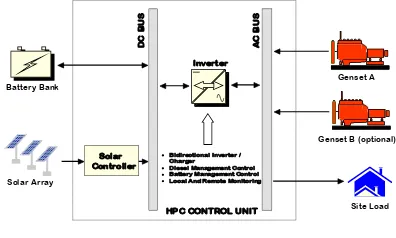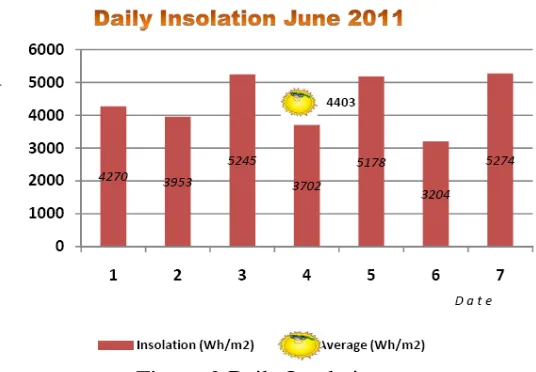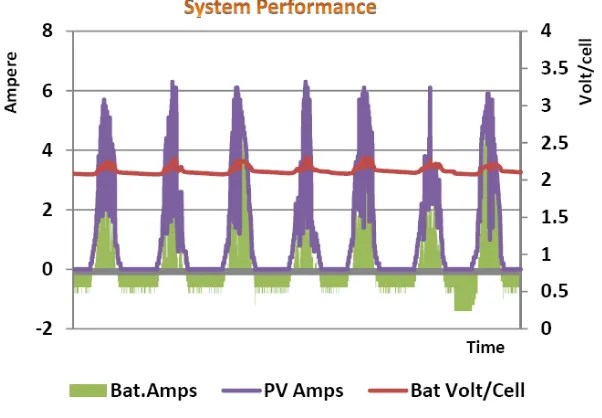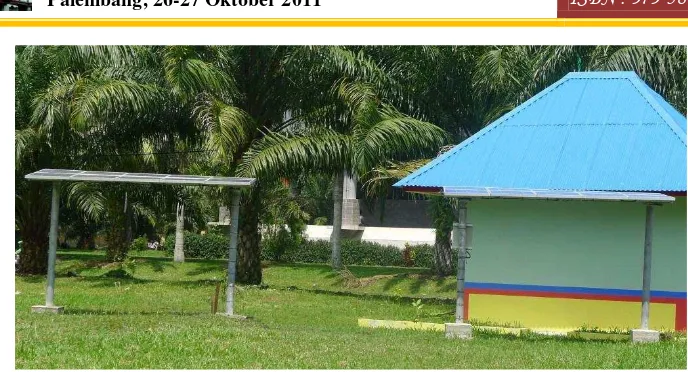Fakultas Teknik Universitas Sriwijaya 55
KMT-4
PHOTOVOLTAIC HYBRID SYSTEM IN THE UNIVERSITY OF
SRIWIJAYA, SOUTH SUMATRA, INDONESIA
Muhammad Faizal1, Adjat Sudradjat2, and Dedi Setiabudidaya3,*
1
Director of RUSNAS Energy, Sriwijaya University, South Sumatra, Indonesia
2
Energy Technology Centre, BPPT Indonesia
3
Department of Physics, Sriwijaya University, South Sumatra, Indonesia
*
Corresponding Author. Tel: (+62)711580743, Fax: (+62)711580056, E-mail:
ABSTRACT
Sriwijaya University makes a research cooperation with the Energy Technology Center, the Agency for the Assessment and Application of Technology (B2TE-BPPT) through RUSNAS program in the field of of photovoltaic system technology. In Indonesia, the PV Hybrid System is one of several alternatives which are taken into consideration by the government to become a resolve option in coping with electricity supply problem in rural areas along the Indonesian archipelago. The hybrid power systems integrate renewable energy technologies with diesel generators, batteries and inverters to provide electrical power. The PV hybrid systems has been installed in the University with the capacity of 1 kWp photovoltaic array, 24 kWh VRLA battery bank,10 kVA Hybrid Power Conditioner (HPC) powering the street light. The system will be extended to 5 kWp PV array and 48 kWh battery bank in the 2011 fiscal year. The preliminary research utilizing the SAM (Solar Advisor Model) software and performance of the system installed will be elaborated in this paper.
Keywords: renewable, technology, photovoltaic, hybrid, SAM
1. INTRODUCTION
Indonesian energy sector is still heavily dependent on non-renewable energies such as fossil fuels, coal and natural gas as sources of energy. The government policy in long term national energy supply through the Presidential Decree No 5/2006 explained that the target of national energy supply should achieve the optimum energy mix in the year of 2025. The contribution of the energy source into the national energy consumption plan to be oil is less than 20 %, gas is more than 30%, coal becomes more than 33%, biofuel becomes more than 5%, geothermal more than 5%, and the renewable energy especially nuclear, hydro, wind and solar will be more than 5%. Renewable energy sources are quite abundant in Indonesia. These are, bio-ethanol as substitution for gasoline, bio-diesel for diesel oil, geothermal, micro-hydro, wind energy and solar energy to generate electricity.
Fakultas Teknik Universitas Sriwijaya 56
is increasing the qualified man-power who are working in the field of photovoltaic system technology.
Contributing to these actions the University of Sriwijaya in Palembang, South Sumatra makes a research cooperation with the Energy Technology Center, the Agency for the Assessment and Application of Technology (B2TE-BPPT) through RUSNAS program in the field of of photovoltaic system technology. In Indonesia, the PV Hybrid System is one of several alternatives which are taken into consideration by the government to become a resolve option in coping with electricity supply problem in rural areas along the Indonesian archipelago.
It has been common practice throughout rural/remote areas`in Indonesia to provide diesel generator for supplying electricity as a power generation is relatively cheap and the time frame to construct power plants is short. Despite these considerations of a capital nature, diesel generator has very poor fuel consumption efficiency at low load and high maintenance costs, furthermore, both fuel and transportation cost is high for remote sites. Examination of the life-cycle costs of hybrid systems, as opposed to conventional diesel generation provides a greater understanding of cost/benefits associated with hybrid power system. Hybrid power systems integrate renewable energy technologies with diesel generators, batteries and inverters to provide electrical power. The PV hybrid systems has been installed in the University with the capacity of 1 kWp photovoltaic array, 24 kWh VRLA battery bank,10 kVA Hybrid Power Conditioner (HPC) powering the street light.
2. INSTALLED SYSTEM
The system was installed in February 2011 comprises of:
a. Photovoltaic array with the capacity of 1 kWp, the nominal working voltage is 120 Volt DC.
b. The battery as an energy storage with the capacity of 24 kWh.
c. 1 Phase Hybrid Power Conditioner (HPC) as a bi-directional inverter with
automatic control with the capacity of 10 kVA.
d. 5 Lamps, 25 watt each and one 150 Watt street light as a loads.
The DSP based one phase Hybrid Power Conditioner (HPC) provides one-phase AC power to loads. The role of the inverter module includes the transfer of power from the photovoltaic array to the load and the importing of power from a diesel generator to charge the battery bank. The battery bank is a back-up power source to meet instantaneous peak loads and supply the load when no diesel generator operation is required. The photovoltaic modules provide power to aid charging the batteries and reduce the load on the diesel generator.
Fakultas Teknik Universitas Sriwijaya 57
Full automatic operation with no break to the supply during transitions from
inverter to diesel generator operation.
No loss of supply on dual diesel generator systems if a diesel generator fails to
start as the alternate diesel generator will automatically be selected.
Diesel generator loading is kept relatively high during its required operating
period giving high fuel efficiency and lower overall maintenance.
Solar resources are fed directly to the site load via the inverter as much as
possible.
Local LCD (liquid crystal display) and keypad for system control, monitoring
instantaneous system data, event logs, data logs and changing set points.
Time and date stamped system data logs and event logs available for
importation into a spreadsheet for analysis via a local RS232 connection.
Remote control and monitoring option available (with local dedicated
telephone line).
Integrated PWM or MPPT solar regulator.
At low load condition when the diesel off-line the battery and photovoltaic output energy operating through inverter, when the load increase to medium load diesel running at optimal loading, and excess diesel generator capacity charge the battery through the HPC. The diesel generator will operate in parallel with inverter when the load came to the peak condition. Inverter converts photovoltaic and battery output energy into AC power. The system completed with the system monitoring and control because comprehensive and uninterrupted monitoring plays an important role. The monitoring system used is SCADA which are measure and record all data parameters and event logs. The data store in internal memory for two years in ten minutes base. The data can be taken anytime locally or by remote system if there is communication line available. Additionally, instantaneous data can be done by the operator on the screen.
The evaluation of the performance is not done entirely, because the component of diesel generator is not available yet. The incoming solar radiation (insolation) data of
1st to 7th of June 2011 is on Figure 2. The daily average is 4,403 kWh/m2 with the
highest of the 7th is 5,27 kWh/m2 and the lowest is 3,702 kWh/m2.
Fakultas Teknik Universitas Sriwijaya 58
The performance of the system is shown in Figure 3. The PV energy output is still higher than the load energy consumed, it can be seen that battery voltage is always higher than 2,1 Volt per cell. Currently the load is 5 lamps with power of 25 watt each, and running for 12 hours.
Figure 3 System Performance
3. SOLAR ADVISORY MODEL (SAM)
The Solar Advisor Model (SAM) is a stand-alone software program created in 2006 by a partnership with the National Renewable Energy Laboratory (NREL) and SNL through the DOE Solar Energy Technologies Program. The program can be
downloaded athttps://www.nrel.gov/analysis/sam/. The model is being continuously
updated and improved and has an active user community that can be accessed at: http://groups.google.com/group/sam-user-group. The version used in this paper is SAM 2010.11.9.
This model is considered a ―system‖ model because it has the ability to model PV
system performance, and perform financial analysis. A useful feature in SAM is that it provides access to many different array performance models described below in Table 1. In terms of radiation inputs, the model will accept either beam and diffuse and calculate total radiation, or total and beam and calculate diffuse radiation.
Table 1. Algorithm Options in SAM for Solar Radiation, Array and Inverter
Performance
Solar Radiation
Array Performance Inverter
• Isotropic Sky • Hay and
Davies
• Reindl • υerez et al.
• Sandia υV array
performance
model (empirical)
• η-parameter performance
model (semi-empirical)
• υVWatts
• Simple-efficiency model
• Sandia inverter
performance model
Fakultas Teknik Universitas Sriwijaya 59
The radiation models in SAM include Isotropic Sky (Liu and Jordan, 1963), Hay and Davies (Davies and Hay, 1980), Reindl (1988) and Perez et al. (1987, 1988). For array performance, Table 1 above shows the four different options. SAM uses the Transient Systems Simulation (TRNSYS) code developed by the Wisconsin Solar
Energy Laboratory as the ‗engine‘ for implementing the array performance models.
For weather and solar insolation, SAM uses TMY2, TMY3, EnergyPlus Weather (EPW) and METEONORM data. Other useful features include the ability to perform sensitivity analysis and optimize against a selected output.
Weather Analytics has kindly provided us with a sample of TMY file for our site. By running the SAM and do some simulations, the output shows some interesting
results (see Figure 4 and Figure 5). The azimuth of the array is around 60o E and the
tilt is less than 12o (see Figure 6).
Figure 4 Contour Plot of the Net Output in kWh at the Location (2.966 oS, 104.688
o
E)
Figure 5 Histogram of the Monthly Net Output in kWh at the Location (2.966 oS,
Fakultas Teknik Universitas Sriwijaya 60
Figure 6 PVFacilityat Sriwijaya University, Indonesia
4. CONCLUSION AND DISCUSSION Conclusion
The load energy is still lower than the PV output energy; it needs to be
calculated precisely to get the optimum energy balance.
More data on the calculation of incoming solar radiation are required to
compare with the SAM calculation. So we can use the SAM calculation to design PV system in Palembang more precisely.
The most favorable system is to add the diesel generator into the system.
Discussion
To complete the efforts of achieving the target of PV Program at the University of Sriwijaya, Indonesia several actions have to be taken such as:
1. Complete the system with adding diesel generator and increase the capacity of
PV arrays and storage battery.
2. Utilize the SAM software optimally, because SAM allows users to investigate
the impact of variations in physical, cost, and financial parameters to better understand their impact on key figures of merit. The figures of merit of these systems include:
System output
Peak and annual system efficiency
Levelized cost of electricity
System capital and operating and maintenance (O&M) costs
Hourly system production
5. ACKNOWLEDGMENTS
The authors gratefully acknowledge the contribution of the Weather Analytics (https://www.weatheranalytics.com) by supplying the sample weather TMY file of the location.
6. REFERENCES
[1] Technology Roadmap: Solar Photovoltaic Energy IEA Technology Roadmaps
OECD/IEA 24 June 2010 | ISBN: 9264088047
Fakultas Teknik Universitas Sriwijaya 61
[3] Rapat Pembahasan Kebijakan Energi Klaster Energi Surya, Kementerian
Energi dan Sumber Daya Mineral, Ditjen Energi Baru Terbarukan dan Konservasi Energi, 2010.
[4] The performance of the first biggest PV-Diesel Hybrid system in Indonesia,
Parlindungan Sihombing and Adjat Sudradjat, World Renewable Energy Congress, Bali 2011.
[5] Investigation of Solar Photovoltaic Simulation Softwares, Mahendra Lalwani
and Mool Singh, International Journal of Applied Engineering Research, Dindigul,
Volume 1, No 3, 2010, p. 585 – 601, Integrated Publishing Association.
[6] World-wide overview of design and simulation tools for hybrid PV systems,
Report IEA-PVPS T11-01:2011
[7] Models Used to Assess the Performance of Photovoltaic Systems, SANDIA




